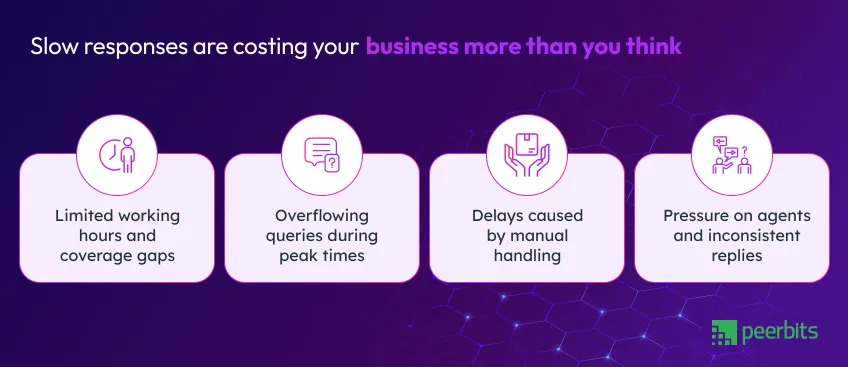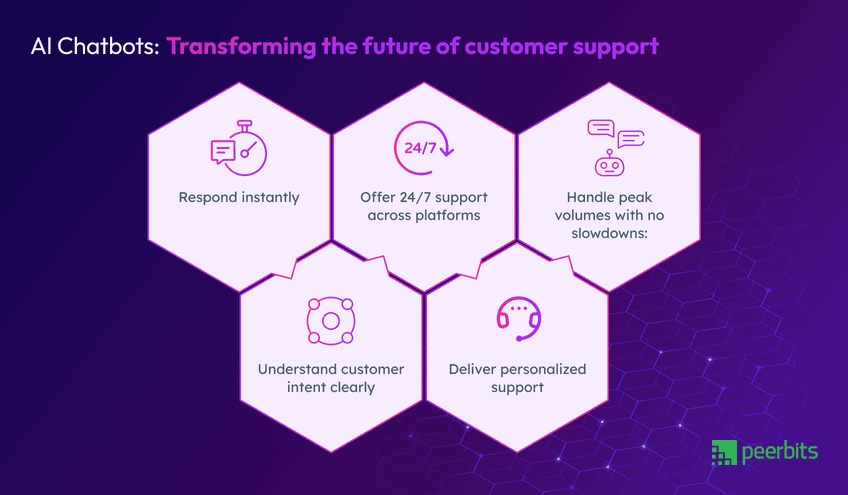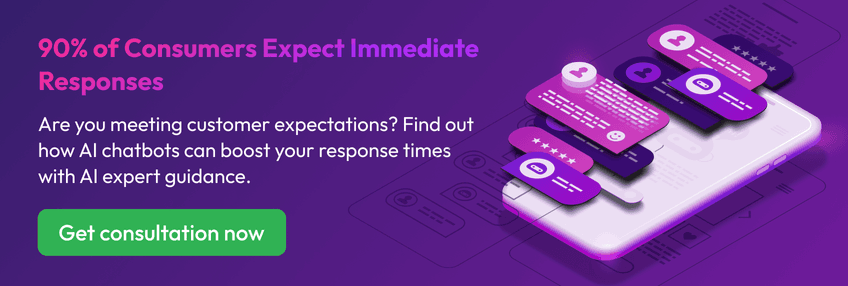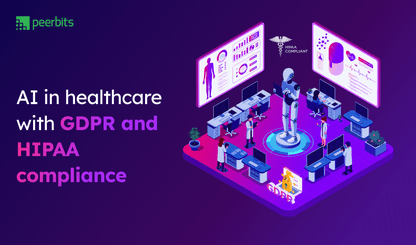Your team’s working hard. The support inbox is full. Agents are jumping between tickets, trying to keep up. But even after all that extra work, customers are left frustrated and agents overworked.
Why? Because customers are waiting too long for replies.
In today’s world, people can order food, book a cab, and even get medical advice instantly. For those, waiting 12 or even 2 minutes for support can seem like an eternity.
Businesses dealing with slow customer service response are not just at risk of losing patience. Instead, they're losing trust, loyalty, and sales.
According to Emplifi, 63% of customers say they would leave a brand because of poor customer experience.
And if you assume hiring more staff can be a fix. Then its extra cost can be burdening, unscalable, and miss the real issue. This is where AI chatbots for customer service comes as a life changing technology.
With real-time replies, smart automation, and availability round the clock, AI chatbot help brands stay responsive, reduce support pressure, and keep customers satisfied at scale.
In this blog, we’ll walk through what’s really causing delays, why response time is a silent killer for retention, how modern AI chatbots for customer service work, and how they’re quietly becoming the go-to instant customer support solution for businesses trying to keep up and stay ahead.
Why quick responses matter today?
Customers don’t just hope for quick replies. They expect them. Today’s habits shaped by instant apps and AI chatbot development services have completely redefined what “good service” means.
That’s not just a preference, but instead, it’s the new standard.
How on-demand culture changed expectations?
From food delivery in 10 minutes to streaming content instantly, people are used to getting what they want when they want it. This mindset now extends to customer support. If a business can’t match that pace, it feels outdated.
Why instant support matters more than ever?
Speed goes beyond convenience, well nowadays it’s a fundamental expectation. A quick response shows:
- Speed is crucial as customers have endless options just a click away.
- Shows customers that their time is valued
- Builds trust right from the first interaction
- Improves customer satisfaction and loyalty
- Drives faster conversions and smoother issue resolution
- Keeps users engaged in a world full of distractions and alternatives
What poor response times actually cost businesses?
With the rise of AI development services, businesses have the power to transform how they communicate. But the ones lagging behind miss out with the following:
- Delayed replies frustrate customers and result in lost revenue.
- Negative reviews, damaged reputation, and churn are common consequences.
- 96% of customers would leave a brand due to poor service (Shep Hyken).
- Slow replies lead to broken trust, not merely delays.
Challenges businesses face with slow customer response
Even with the best intentions, many businesses fall behind when it comes to delivering quick, consistent support. These delays add up and affect customer satisfaction in big ways.

Limited working hours and coverage gaps
Without 24/7 customer support with AI chatbots, businesses rely solely on human teams that work fixed hours. This creates gaps where customer queries go unanswered, leading to dissatisfaction and missed opportunities.
Consumer expectations are shifting
As reported by Businesswire,
More than 52% of Americans have expressed confidence in AI's potential to deliver round-the-clock service(24/7), eliminate wait times, and provide automated help when they prefer self-service over human interaction.
Overflowing queries during peak times
Handling peak query volumes with traditional chatbots isn’t common for many teams. When traffic surges, support teams struggle to respond fast enough, causing backlogs that directly hurt customer satisfaction.
Delays caused by manual handling
Traditional workflows depend heavily on human agents. Without a smart AI chatbot for customer service, tickets take longer to be sorted and resolved, often increasing friction for the end user.
Pressure on agents and inconsistent replies
When agents are overloaded, consistency drops. AI chatbots vs human agents show a clear benefit here—AI can maintain a steady tone, quick replies, and uniform information, reducing customer frustration during high-pressure times.
AI Chatbots & how they work?
AI chatbots for customer service have quickly become an essential tool for businesses aiming to provide faster, more efficient support. These automated assistants use artificial intelligence and machine learning to engage with customers, provide solutions, and streamline operations.
But how exactly do they work, and how are they different from human agents? Let's break it down and explore the key features that make AI chatbots so effective.
Read more: Machine Learning vs. Traditional Programming: Key differences explained
Breaking down the basics of AI chatbots
At their core, AI chatbots are designed to automate customer interactions. Using advanced algorithms, they can understand and process user input, provide instant responses, and learn from each interaction to improve over time.
Whether it’s answering frequently asked questions, helping customers with troubleshooting, or processing simple requests, AI chatbots handle it all with efficiency.
How they’re different from human agents?
| Aspect | Human agents | AI chatbots |
|---|---|---|
| Empathy & problem-solving | Brings empathy, emotional intelligence, and problem-solving skills to interactions | Limited in empathy, relies on pre-programmed responses |
| Speed | Response time can vary due to human workload | Instant responses, no waiting time |
| Breaks | Requires breaks, shifts, and time off | Works 24/7, no breaks needed |
| Task handling | Handles complex, unique, or sensitive queries | Excels at handling repetitive tasks |
| Multi-tasking | Handles one conversation at a time | Can manage multiple conversations simultaneously |
| Consistency | Responses can vary based on agent and situation | Provides consistent responses every time |
Types of AI chatbots
-
Text-based chatbots: They handle written conversations through websites, apps, and social media.
-
Voice AI chatbots: They allow customers to interact using voice commands, improving convenience and natural communication.
-
Hybrid chatbots: They combine both text and voice features, offering versatile interaction options.
What AI chatbots can do in customer support?

AI chatbots for customer service have moved from being optional add-ons to becoming a central part of how modern businesses handle support. Whether it’s through a company’s website, mobile app, or messaging platforms like WhatsApp, they’re now actively managing real conversations across industries.
What makes them this capable? It starts with NLP in AI chatbots. They don’t just spit out pre-set answers. They understand what customers are really asking and improve as they go—learning from each interaction to respond better next time.
Here’s how they’re changing the way support teams operate:
-
Respond instantly: Customers don’t want to wait. AI chatbots provide instant customer support solutions, stepping in with fast replies the moment a query comes in.
-
Offer 24/7 support across platforms: With no concept of office hours, chatbots stay active round the clock, offering 24/7 customer support with chatbots whether it’s day or night.
-
Handle peak volumes with no slowdowns: Whether it’s a flash sale or an unexpected spike in queries, AI chatbots manage large volumes smoothly without putting pressure on your human team.
-
Understand customer intent clearly: With natural language processing, bots focus on what the customer means, not just what they type. This leads to better, more relevant responses.
-
Deliver personalized support: By tapping into past interactions and behavior, AI chatbots provide personalized customer support with AI that feels tailored, not generic.
With these capabilities, businesses aren’t just speeding up support. They’re improving customer satisfaction with AI chatbots while reducing customer support costs and making their teams more efficient.

AI chatbots: Real-World customer service impact
Top global brands are adding AI chatbots into their business. Why? Just to keep up with tech trends? No. It’s because these bots are solving real problems like slow responses, inconsistent answers, and pressure on support teams.
From retail to banking and travel, AI chatbots for customer support are now handling millions of queries with speed and clarity.
H&M
Their AI-powered chatbot supports customers with product search, order updates, and returns. This keeps response time low and shopping experiences smooth.
AirAsia
The airline’s AVA chatbot speaks multiple languages and manages booking changes, refund requests, and travel queries without delays.
Bank of America
Erica, their AI assistant, handles transaction alerts, spending insights, and account information, helping reduce human support loads while improving CX.
L’Oréal
This beauty giant uses chatbots to provide personalized product suggestions and tutorials, blending support and marketing into one smart interaction.
Amazon
Its AI chatbots manage order issues, delivery questions, and returns. They adapt to user behaviour, offering fast and reliable service round the clock.
Verizon
From billing to tech support, Verizon’s AI virtual assistant solves customer issues and even supports human agents with real-time suggestions.
Uber
AI chatbots handle rider and driver questions related to payments, trip concerns, and profile settings, cutting down response time and maintaining app efficiency.
Use cases of AI chatbots across industries
AI chatbots are stepping up across industries, not just to save time but to solve real business challenges. They’re helping brands respond faster, handle more queries, and offer smoother customer journeys. Whether it's retail, healthcare, or finance, their impact is hard to miss.
Tracking orders and handling shipping questions
- Amazon utilizes its AI assistant, Rufus, to provide real-time updates and handle customer inquiries about order statuses.
- Walmart has integrated AI chatbots to assist customers with tracking orders and answering shipping-related questions, enhancing the overall shopping experience.
Answering product or service-related queries
- Lowe's employs its AI-powered chatbot, LoweBot, to answer product-related questions and assist customers in locating items within stores.
- Victoria's Secret uses AI chatbots to provide information on product availability, sizes, and store locations, improving customer service efficiency.
Managing appointments and follow-Ups
- Emitrr offers AI-powered appointment scheduling solutions that help businesses streamline bookings and reduce no-shows.
- Google's "Ask for Me" feature allows users to book appointments by having AI call businesses on their behalf, facilitating seamless scheduling.
Assisting with payments, refunds, and transactions
- Klarna has implemented an AI chatbot developed in collaboration with OpenAI to handle customer service inquiries, including payment and refund issues, effectively performing the work equivalent to 700 full-time agents.
- Appy Pie provides AI-powered chatbots that assist with payment processing and transaction-related queries, enhancing the customer experience.
AI Chatbot Concerns—Debunked
Let’s be honest, not every business feels confident jumping into AI chatbots right away. Some doubts are totally fair and pretty common. Here are a few big ones that usually pop up:
Will my customers accept chatbot replies?
It’s natural to wonder if people want to talk to bots. The truth is, they don’t mind as long as the bot is helpful, fast, and polite. Most users are happy when they get quick answers without waiting in a queue.
Can chatbots really understand human intent?
Thanks to Natural Language Processing (NLP) and machine learning, AI chatbots can catch what customers mean, not just what they type. While they’re not mind-readers, they’ve gotten much better at understanding context and tone.
What happens if they give wrong answers?
Mistakes can happen, but smart bots learn from them. You can also train them with fallback responses, loop in live agents when needed, and improve their replies over time through feedback and data.
How do chatbots handle complex queries?
Chatbots can handle a lot, but when it comes to really tough or complex questions, they might need to escalate to a human agent. The key is balancing automated replies and human intervention to ensure smooth service.
Conclusion
We’ve explored how today’s customers expect instant support, and how AI chatbots for customer service help meet those demands. Delayed replies do more than frustrate, they break trust and push customers toward competitors.
Quick responses, on the other hand, create better experiences and drive stronger loyalty.
Whether it’s tracking orders, answering product questions, or managing transactions, AI chatbots simplify support by handling routine queries. This gives your team room to focus on the work that really matters.
Fast support isn’t a luxury anymore. It’s what customers expect. And AI chatbots make it possible.

FAQ's
While AI chatbots are improving, they’re still not quite like chatting with a human. But with personalization, the right tone, and smart design, they can make the interaction feel much more natural. It's all about managing customer expectations!
Security is always a concern with technology. The best chatbots are integrated with strong security measures, ensuring that sensitive customer information stays safe. But businesses need to implement robust encryption and data protection practices.
Chatbots are great at answering questions, but how do you know they’re actually helping your business? Businesses need the right KPIs—like response times, resolution rates, and customer satisfaction scores—to measure the true impact of their chatbot.








